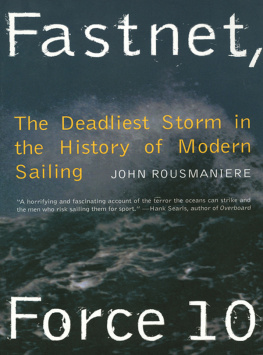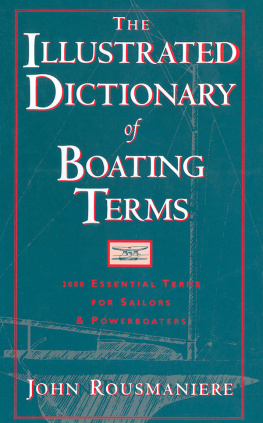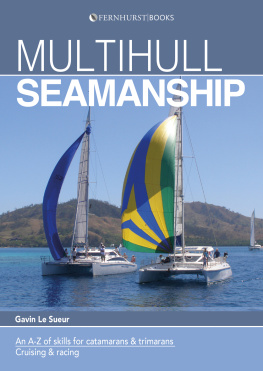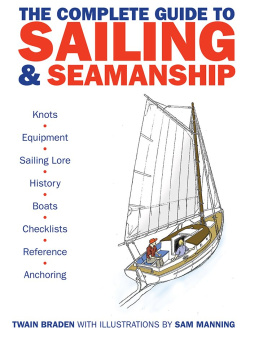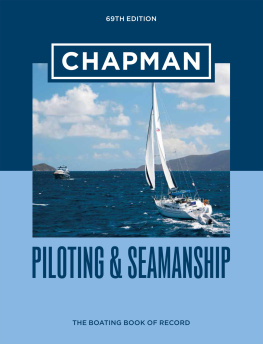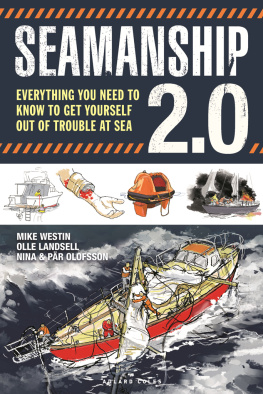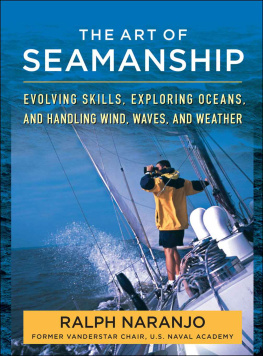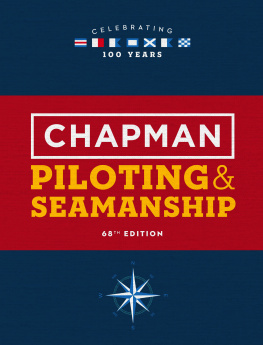Rousmaniere - The Annapolis Book of Seamanship
Here you can read online Rousmaniere - The Annapolis Book of Seamanship full text of the book (entire story) in english for free. Download pdf and epub, get meaning, cover and reviews about this ebook. year: 2014, publisher: Simon & Schuster, genre: Romance novel. Description of the work, (preface) as well as reviews are available. Best literature library LitArk.com created for fans of good reading and offers a wide selection of genres:
Romance novel
Science fiction
Adventure
Detective
Science
History
Home and family
Prose
Art
Politics
Computer
Non-fiction
Religion
Business
Children
Humor
Choose a favorite category and find really read worthwhile books. Enjoy immersion in the world of imagination, feel the emotions of the characters or learn something new for yourself, make an fascinating discovery.

- Book:The Annapolis Book of Seamanship
- Author:
- Publisher:Simon & Schuster
- Genre:
- Year:2014
- Rating:4 / 5
- Favourites:Add to favourites
- Your mark:
- 80
- 1
- 2
- 3
- 4
- 5
The Annapolis Book of Seamanship: summary, description and annotation
We offer to read an annotation, description, summary or preface (depends on what the author of the book "The Annapolis Book of Seamanship" wrote himself). If you haven't found the necessary information about the book — write in the comments, we will try to find it.
The Annapolis Book of Seamanship — read online for free the complete book (whole text) full work
Below is the text of the book, divided by pages. System saving the place of the last page read, allows you to conveniently read the book "The Annapolis Book of Seamanship" online for free, without having to search again every time where you left off. Put a bookmark, and you can go to the page where you finished reading at any time.
Font size:
Interval:
Bookmark:

Thank you for downloading this Simon & Schuster eBook.
Join our mailing list and get updates on new releases, deals, bonus content and other great books from Simon & Schuster.
C LICK H ERE T O S IGN U P
or visit us online to sign up at
eBookNews.SimonandSchuster.com

I can only say here that much comes to one in practice, and that, with such as love sailing, mother-wit is the best teacher, after experience.
Joshua Slocum, Sailing Alone Around the World
No matter how many hundreds of times in your life you have sailed, each trip is a brand new adventure and theres something new to learn. The wind and the water always help make it so.
Cornelius Shields
The Seamanship Ethos
The art of sailing, maneuvering, and preserving a ship or a boat in all positions and under all reasonable circumstances.
This classic definition of seamanship (to which I would add and some unreasonable conditions) has guided the preparation of this book for 30 years through four editions. Much has changed in boats, sails, and electronics, but that definition is as valid and essential today as it was in 1983. In these pages my concern is with you, the sailor, and what you should know and do in order to enjoy this extraordinary pastime as you engage with boats and the craft of handling them ably and safely on the sea, on lakes, on rivers, or wherever else you sail.
For all the technology of sailing, for all its theories and skills and high-tech equipment, for all its dreams of glory, what sustains this sport that is much more than a sport this pastime is the depth of feeling that men and women sailors share for the water and for boats. Admiral Robert W. McNitt wrote in his history of sailing at the U.S. Naval Academy that for all the time he had spent in naval vessels, the true meaning of the seaand the source of his passion for itfirst became clear to him in a sailboat race, when as a young ensign he raced to Bermuda. Like human attachments, this romance cannot be taught or forced, he affirmed. It comes gently during a midwatch in the soft warm moonlight of the Gulf Stream, in the crashing roar of a sudden squall, and in the dawn of a new day at sea. It comes most easily and naturally under sail.
The fact that youre reading this book indicates that you dont have to be told about the lure of wind, water, and boats. You may, like me, have a vivid memory of stepping into a boat for the first time. In my case it was at the age of eight, at a summer camp on the Kennebec River in Maine. Perhaps you, also like me, were enchanted and also a little dismayed by how strange it all seemed, with the unfamiliar equipment and the curious language (what, exactly, is the difference between a jib and a jibe, between leeway and a leeboard?).
As I began to love that strangeness and the challenges that came with boats and the water, I realized that I wasnt alone. My father was a lifelong sailor. The beatific look on his face in the photograph on page 162 indicates how much he adored all this, the multitude of joys and challenges rolled into the one magnetic, enchanting object that is the boat. That intense, spiritual commitment was shared by a friend and sometime competitor of my dads, Cornelius Shields. Corny Shieldss conversion to sailing occurred when he was first handed the tiller. He was transformed, he later wrote: It didnt take 20 seconds before I was hit by a welling-up of emotion so strong its almost indescribable. It was like a theater curtain going up. Suddenly, I was tremendously happy.... Never, before or since, has anything opened up to me so spectacularly.
The great mariner and writer Joseph Conrad called the community of sailors our fellowship in the craft and mystery of the sea. We all know what that mystery is: its the entrancing, even addictive experience behind my fathers smile and Corny Shieldss exuberance. E. B. White put his finger on that mystery when he wrote, I cannot not sail. As for the craft that Conrad referred tothat is seamanship. Its an ever-expanding set of skills, and much more. Seamanship is an attitude, a hope, an ethos. Its a quest that guides us, if we are willingsometimes pulling, sometimes pushingin the right direction. In other words, seamanship is both a technical discipline that you will never stop mastering and a caring, alert state of mind we must never cease developing and improving.
Long ago a pioneer cruising sailor, Richard T. McMullen, compared the mixed joys and discomforts of sailing a boat to picking roses off a thorny bush. There is the occasional bloody finger, yes, indeed there is. Our calling as sailors is to attempt to master the skills and attitudes of seamanship that help identify those thorns and avoid themin other words to be sailors who are better, safer, and also happier because we know the thorns are there, alongside the roses.
After a series of serious sailing accidents in 2011 and 2012, a sailor asked this question in Scuttlebutt , a sailors blog: How does the average sailor get enough experience to be safe at sea? In reply, my friend Brad Avery, who is director of the Orange Coast College Sailing and Seamanship Program in Newport Beach, California, said that the premise that there can be enough seamanship is mistaken. We are never safe at sea, whether we are professionals or amateurs. We are always one bad decision away from disaster. My goal is to sail error-free on each cruise or race, but I know this is impossible to achieve. The quest for a voyage free of mistakes goes on. Time on the water, training, humility, and constant vigilance are the keys to being safer.
Avery concluded with these wise words: Knowing youre never safe also helps. Thoughts like this run throughout maritime history. Conrad expressed the idea a little differently: A seaman laboring under an undue sense of security becomes at once worth hardly half his salt. Herman Melville wrote in Moby-Dick that the good mariner feels just enough of trepidation to sharpen all his faculties. Complacency is foreign to seamanship. Every time an effort has met with success, we should humbly decline to claim too much credit. Circumstance, luck, and other factors far beyond our control inevitably play a part. Absence of failure is not, in itself, a proof of absolute success.
The best sailors I know are deeply concerned about seamanship and safety. To quote an able seaman with whom I have sailed many miles, Howard Lapsley, Safety and performance are not mutually exclusive.
Let me end by repeating the wish I extended 30 years ago on the first page of the first edition of The Annapolis Book of Seamanship : May your days and nights afloat be as happy and interesting as mine have been, and may you never make the mistake of believing that you know all there is about sailing. Nobody knows it all. Nobody can know it all, but here (I hope) you will learn at least a little.

J OHN R OUSMANIERE
September 1, 2013
Note: Unless otherwise specified, all miles are nautical miles, all boat lengths are overall lengths, and all degrees are magnetic degrees.
The 4th edition of The Annapolis Book of Seamanship is an extensive update and development of its predecessors. One-third of the text is new, and so are many photos (almost all of Mark Smiths brilliant drawings remain). Through all this, the books mission has not changed. The aim for 30 years has been to advise you the sailor on essential gear, skills, and attitudes that will enhance your pleasure and safety wherever you sail, in whichever boat you sail.
Font size:
Interval:
Bookmark:
Similar books «The Annapolis Book of Seamanship»
Look at similar books to The Annapolis Book of Seamanship. We have selected literature similar in name and meaning in the hope of providing readers with more options to find new, interesting, not yet read works.
Discussion, reviews of the book The Annapolis Book of Seamanship and just readers' own opinions. Leave your comments, write what you think about the work, its meaning or the main characters. Specify what exactly you liked and what you didn't like, and why you think so.

